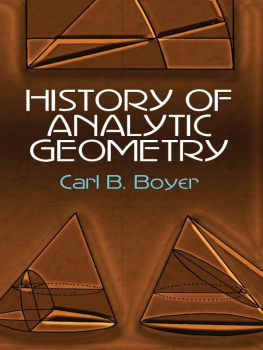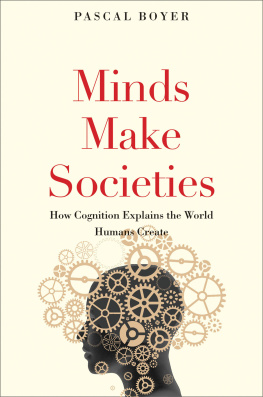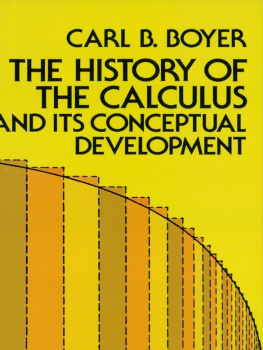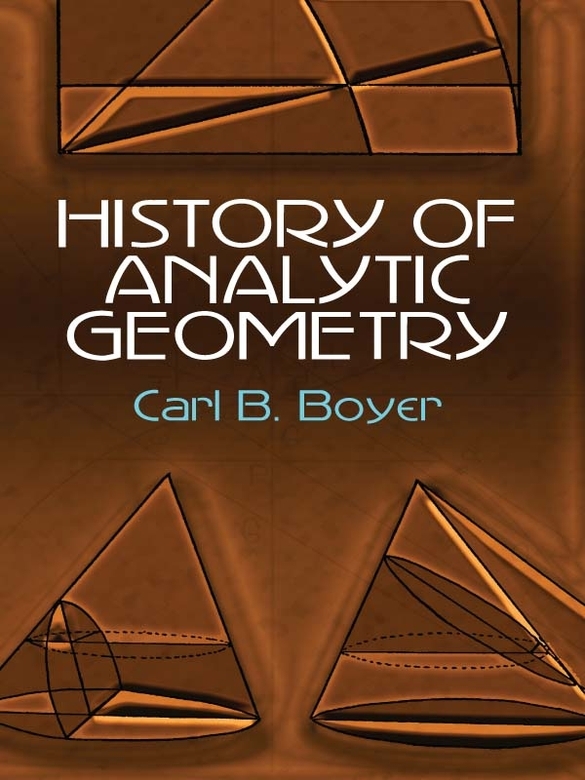The works listed here are selected for their importance or their relevance. For purposes of convenience the collected works of an author, where available, are cited in preference to scattered papers. Further bibliographic references will be found in the footnotes of the text above.
I. Some Important Primary Sources Illustrating the History of Analytic Geometry (arranged roughly in chronological order)
[Neugebauer, O., and A. Sachs], Mathematical cuneform texts (American Oriental Series, vol. XXIX). New Haven, Conn., 1945.
Illustrates the earliest applications of algebra to geometry.
[Chase, A. B., L. S. Bull, H. P. Manning, and R. C. Archibald], The Rhind mathematical papyrus. 2 vols., Oberlin, 19271929.
Illustrates the application of number to geometry in Egypt.
[Heath, T. L.], Apollonius of Perga, Treatise on conic sections. Cambridge, 1896.
This excellent English edition of the Conics includes an introduction which presents an extensive history of the conic sections before Apollonius.
[Heath, T. L.], The works of Archimedes. Cambridge, 1897.
Important for the knowledge of the Conics in antiquity, including Archimedes graphical solution of cubic equations.
[Thomas, Ivor], Selections illustrating the history of Greek mathematics. 2 vols., Cambridge, Mass., 19391941.
A convenient source book of fragments pertaining to the Greek equivalent of analytic geometry.
[Ver Eecke, Paul], Pappus of Alexandria, La collection mathmatique. 2 vols. Paris and Bruges, 1933.
A readily available edition of an important source of inspiration in the development of analytic geometry.
[Wieleitner, Heinrich], Der Tractatus de latitudinibus formarum des Oresme, Bibliotheca Mathematica (3), XIII (1913), 115145.
Includes valuable commentary and analysis of the work of the most important medieval precursor of analytic geometry. See also the article on Oresme by Wieleitner listed in part II of this bibliography.
Vite, Franois, Opera mathematica (ed. by van Schooten, Lugduni batavorum, 1646).
Contains applications of algebra to geometry by the most important early modern precursor of Descartes and Fermat. For French translations of parts of his work see Bullettino di Bibliografia e di Storia delle Scienze Matematiche e Fisiche, I (1868), 223276.
Fermat, Pierre de, Oeuvres. Ed. by Paul Tannery and Charles Henry, 4 vols. and supp., Paris, 18911922.
Contains the Latin, and also French translation, of the Introduction to loci, as well as of other works bearing upon analytic geometry. The Latin of the Introduction to loci is found also in the Varia opera mathematica of Fermat (Tolosae, 1679).
Descartes, Ren, The geometry. Transl. by D. E. Smith and Marcia L. Latham, with a facsimile of the first edition, 1637. Chicago and London, 1925.
A convenient edition and translation, with notes. For other aspects of the geometrical work of Descartes, see his Oeuvres (ed. by Charles Adam and Paul Tannery, 12 vols. and supp., Paris, 18971913).
Roberval, G. P. de, Divers ouvrages, Mmoires de lAcadmie Royale des Sciences depuis 1666 jusqu 1699, VI (Paris, 1730), 1478.
Pages 94246 contain work on the derivation of the equations of loci and on the graphical solution of cubics and quartics.
Van Schooten, Frans, Geometria a Renato Des Cartes. 2nd ed., 2 vols., Amstelaedami, 16591661.
One of the most important works in the history of analytic geometry. Besides very extensive commentary on Cartesian geometry by Van Schooten, the 2nd edition contained the Elements of curved lines of Jan de Witt, sometimes called the first textbook of analytic geometry. Van Schootens work included also significant additions to analytic geometry by Debeaune and others. A third edition appeared in 1683. The first edition of Leyden, 1649, did not contain the work of de Witt.
Sluse, Ren de, Mesolabum. 2nd ed., Leodii Eburonum, 1668.
This book of means was an important link in the Cartesian graphical solution of equations. Cubics and quartics are solved by intersecting conic sections. The first edition appeared in 1659.
Wallis, John, Opera. 3 vols., Oxonii, 16931699.
This is the best edition of Wallis works. The important Treatise on conic sections is also found in the more readily accessible Opera mathematica (2 vols., Oxonii, 16561657).
Huygens, Christiaan, Ouevres compltes. 22 vols., La Haye, 18881950.
Important for correspondence with mathematicians of the time, especially Sluse. Huygens was one of the early Continental writers to understand negative coordinates.
Lahire, Philippe de, Nouveaux lmens des sections coniques, les lieux gomtriques, la construction ou affection des quations. Paris, 1679.
The most important analytic work of a man otherwise known as a great synthetic geometer. It is in the strict Cartesian tradition and appeared again in 1701.
Ozanam, Jacques, Trait des lignes du premier genre; trait des lieux gomtriques; trait de la construction des quations. Paris, 1687.
This rather uninspired work is in harmony with the ideas of Descartes and closely resembles the work of Lahire.
Craig, John, Tractatus mathematicus de figurarum curvilinearum quadraturis et locis geometricis. Londini, 1693.
Contains the important Nova methodus determinandi loca geometrica with the equivalent of the modern characteristic for determining the nature of a conic section.
Leibniz, G. W., Mathematische Schriften. Ed. by C. I. Gerhardt. Gesammelte Werke. Ed. by G. H. Pertz. Third series, Mathematik, 7 vols., Halle, 18491863.
Especially useful for Leibniz correspondence with the Bernoulli brothers.
Bernoulli, Jacques, Opera. 2 vols., Genevae, 1744.
Important for the graphical solution of equations and for the use of polar coordinates.
Bernoulli, Jean, Opera omnia. 4 vols., Lausannae and Genevae, 1742.
Contains anticipations of solid analytic geometry.
Guisne, N., Application de lalgebre a la geometrie. Paris, 1705.
A popular analytic geometry of the first half of the eighteenth century.
Newton, Sir Isaac, Opera quae exstant omnia. Ed. by Samuel Horsley, 5 vols., Londini, 17791785.
This edition, and the Opuscula mathematica, philosophica et philologica (3 vols., Lausannae and Genevae) are convenient for those who read Latin. Many of the treatises of importance in the history of analytic geometry are available also in English: The method of fluxions (London, 1736), for polar coordinates; Universal arithmetick (London, 1769 etc.), for the graphical solution of equations; Enumeration of lines of the 3rd order (London, 1760), on graphical representation. An extensive account of the last-mentioned is found also in W. W. R. Balls article, On Newtons classification of cubic curves, London Mathematical Society, Proceedings, XXII (1890), 104143.
LHospital, G. F. A. de, Trait analytique des sections coniques. Paris, 1707.
The most popular text on analytic geometry of the eighteenth century, this work appeared in numerous editions.
Varignon, Pierre, Nouvelle formation de spirales, Mmoires de lAcadmie des Sciences, 1704, pp. 69131.
An early instance of the use of polar coordinates.
Rolle, Michel, De levanoissement des quantitez inconnus dans la gomtrie analytique, Mmoires de lAcadmie des Sciences, 1709, pp. 419450.
One of the first uses in print of the name analytic geometry. The article is on the graphical solution of equations.
Reyneau, Ch. R., Analyse dmontre. 2 vols., Paris, 1708.
A work resembling that of LHospital, but not so well known.













